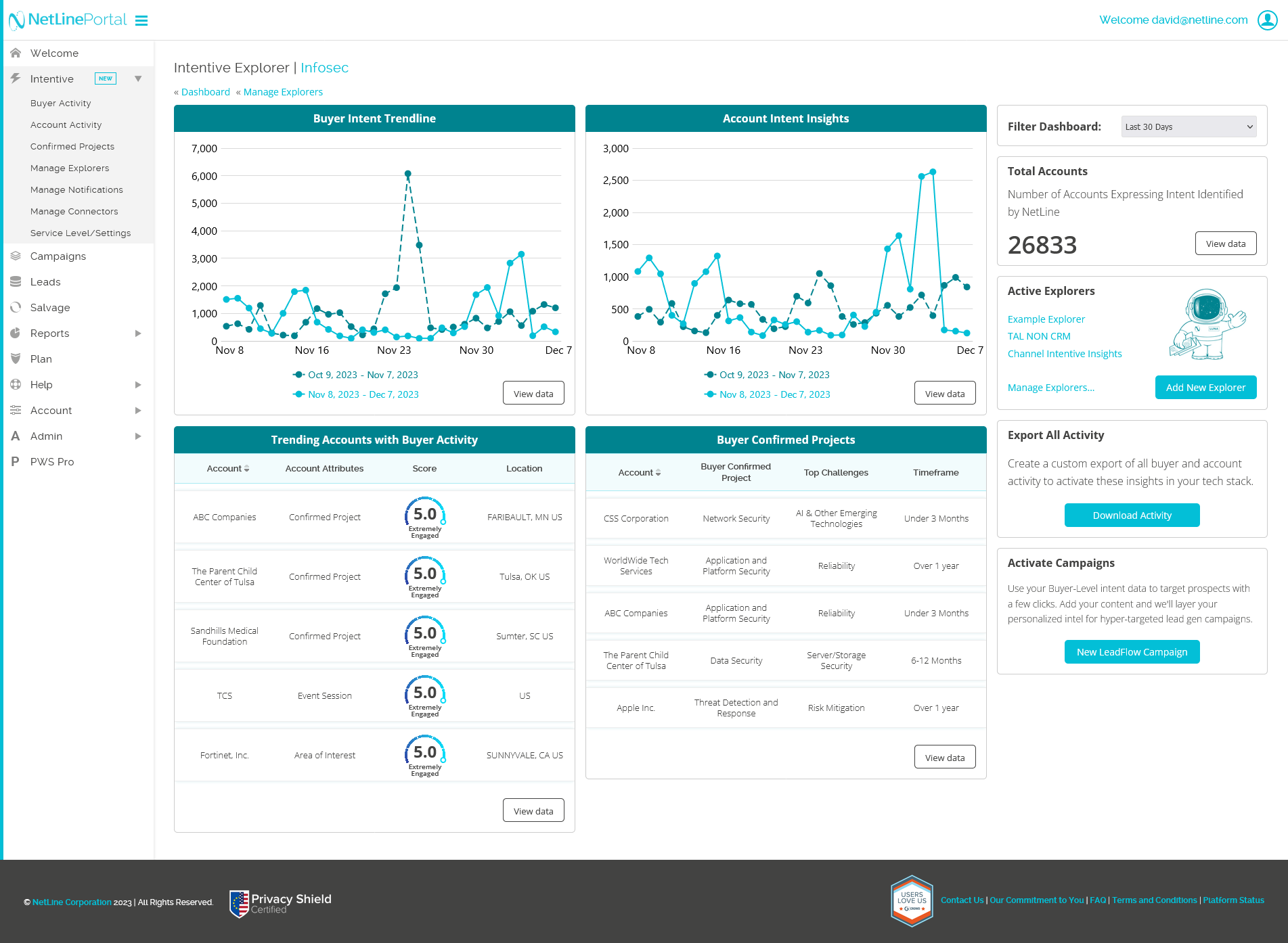In this post, we are going to take a look at how B2B marketers can effectively integrate intent data into their martech stack to unlock its full potential.
By incorporating intent data into key components of your martech stack, you can personalize messaging, improve lead scoring, and deliver targeted content that resonates with your audience.
Key components of a martech stack that can effectively leverage intent data
Let’s face it, when it comes to marketing technology, there’s an awful lot out there to choose from.
According to Chiefmartech, which has been keeping track of this phenomenon over the past twelve years, the number of martech solutions has gone from about 150 in 2011 to more than 11,000 in 2023.
Yes, you read that correctly. No wonder it’s easy to get overwhelmed by your choices.
Hopefully, we can make it a little easier for you. We’ve identified four key components of a martech stack that enables marketers to effectively use intent data to its fullest potential.
Image by Iconics Avenue via Pixabay
- CRM and Marketing Automation Platforms: This is the backbone of your martech stack. These systems store and manage your customer and prospect data, as well as handle your marketing campaigns.Integrating intent data into these platforms enables you to personalize your messaging based on the behaviors and interests of your target audience as well as identify the right moments to engage with prospects based on their intent signals. It also helps improve lead scoring, allowing you to identify the most promising prospects.
- Intent Data Provider: Choosing the right intent data provider is crucial for accessing accurate and relevant data. Partnering with a reliable intent data provider ensures access to high-quality data to drive effective marketing strategies.It’s also important that any provider you choose to work with offers first-party buyer-level intent data. First-party intent data is derived directly from your target audience’s interactions with your own digital properties, providing the most accurate and relevant insights.
Importantly, you also want to confirm that the intent data provider you choose can integrate with your other marketing technologies.
- Data Management Platform: Siloed or inaccurate data can stand in the way of making worthwhile data-based decisions. That’s why having a data management platform (DMP) is a key component of any martech stack. DMPs play a vital role in maintaining data hygiene and consistency across your stack.It also helps organize and centralize your data from various sources—ensuring that it is accurate and up-to-date. CRM platforms, marketing automation tools, and other systems create a unified view of your audience. This enables you to derive more meaningful insights and execute targeted marketing campaigns.
- Content Management System (CMS): A CMS empowers you to create and publish targeted content that aligns with the insights derived from intent data.By integrating intent data into your CMS, you can tailor your content to match the specific interests and needs of your audience. This approach enhances engagement and establishes your brand as a trusted resource in the eyes of your audience.
Integrating intent data into CRM and marketing automation platforms improves personalization and messaging
Image via ChatGPT 4/DALL-E
Now that we’ve given you the short list of essential components you’ll need in your marketing technology stack, let’s take a closer look at how to integrate intent data into your CRM and marketing automation platforms.
As we briefly touched on, CRM and marketing automation platforms are the technologies that prop up the rest of your martech stack. Having a marketing automation platform, in particular, makes it easier to scale your marketing efforts and is essential when scaling marketing strategies such as pairing intent data with ABM.
To integrate intent data effectively into your CRM and marketing automation platform, the first step is to work with your intent data provider and CRM/marketing automation platform to set up the data integration process. Because you did your homework ahead of time, you already know that such integration is possible and will result in a seamless flow of intent data into your existing systems.
From there you can utilize intent data to trigger specific actions within your CRM and marketing automation platforms. An example of this would be to set up your systems to send out a personalized email based on specific intent signals. It can also be used to adjust lead scores based on the level of engagement and intent exhibited by prospects.
By tailoring your marketing efforts based on intent signals and engagement, you’ll have the ability to deliver more relevant and timely messages. Indeed, once intent data is integrated into your CRM and marketing automation platform, you’ll be able to create targeted messaging that resonates with specific audiences.
Maintaining data hygiene and consistency across your Martech stack
To guarantee accurate insights that lead to effective marketing campaigns, it’s crucial to maintain data hygiene and coherence across your martech stack. Here are some best practices to follow to help clean, accurate, and up-to-date across your stack:
Standardized Naming Conventions: One of the best ways to ensure consistency across your tech stack is to establish standardized naming conventions. Using standardized naming helps to maintain consistency and avoid confusion when working with data across different platforms. It makes it easier to identify and align data elements.
In creating naming conventions, Forrester advises that you “take into consideration how users will locate content, assets, and programs, how the company needs to report on tactic and program performance, and how it wishes to segment and message to its customer base.”
Define Data Ownership and Management: Do you know who “owns” each type of data within your martech stack? Does marketing have ownership or does IT claim responsibility? It’s important to assign responsibility to individuals or teams to ensure data accuracy, completeness, and timeliness.
Regular Data Cleaning and Updates: Once you’ve determined who is responsible for the various types of data coming from your martech stack, establish a schedule for regular data cleansing and updates. Implement data hygiene practices to remove duplicate or outdated records and enrich data with additional insights.
Following this practice will assist in assuring that your intent data remains a valuable asset in driving effective strategies.
Measuring the impact of intent data on martech stack performance
Of course, you can’t just integrate intent data into your martech stack and just assume it will bring you all the insights you need and have a positive effect on your marketing.
As with all things marketing, it’s important to determine the impact that intent data has on the performance of your martech stack and make sure the investment in resources has paid off.
Start by defining the metrics that align with your business goals and objectives. These metrics may include conversion rates, pipeline velocity, revenue generation, or ROI. Select the metrics that provide meaningful insights into the effectiveness of your intent data-driven marketing campaigns.
Next, use attribution models to accurately measure the impact of intent data on your marketing campaigns. Attribution models help you understand the contribution of different touchpoints and marketing channels make towards conversions and revenue generation. By attributing value to intent data-driven interactions, you can quantify its impact.
Treat your martech stack as an ongoing experiment. Continually test and optimize your strategies, utilizing intent data to enhance performance over time. Conduct A/B tests and analyze data-driven insights to understand what works best for your target audiences.
Iterate and refine your strategies based on the insights you’ve gained. By embracing a data-driven optimization mindset, you can uncover new growth opportunities and maximize the value of intent data.
Conclusion
Integrating intent data into your martech stack is crucial for B2B marketers aiming to drive personalized and targeted marketing efforts.
By leveraging intent data within your CRM and marketing automation platforms, you can enhance your messaging, improve lead scoring, and increase the effectiveness of your campaigns.



